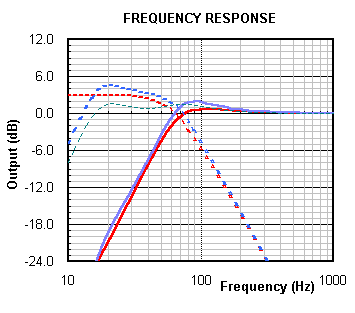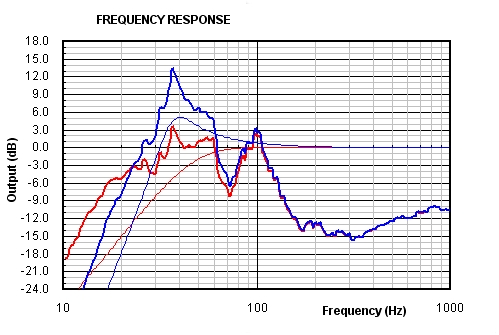Car Audio
20 October 2018
Designing and building a car audio subwoofer is in some ways very similar to designing a subwoofer for your home, and in some ways very different. This page attempts to discuss the design and construction of car audio subwoofer systems.
Why should I build a car audio subwoofer?
The reasons for building a subwoofer for your car remain the same as the reasons
for building one for your home: typically the main loudspeakers, which in car audio
systems are usually 4"-6.5" drivers mounted in the front doors or in the dash,
are simply not capable of reproducing the lower bass frequencies cleanly at any
significant volume. If these loudspeakers are relieved from trying to play the lower bass
frequencies, they will sound better at higher volume levels. And, as is the case with home
subwoofers, a car audio subwoofer can be located anwhere within the listening area, though
the car's trunk usually ends up as the final location for the subwoofer for practical
reasons.
What type of system should I use?
As with home audio systems, there are five basic types of subwoofers systems that
can be used: sealed, ported, bandpass, passive radiator and transmission line systems.
However, the best type of subwoofer system for in-car use is usually the sealed system, as
(1) the box size requirements are usually the lowest for sealed systems, and (2) the
12dB/oct rolloff of a sealed system is a perfect match for the free 12dB/octave rise in
response below 60~80 Hz that you get in a car because of cabin gain. The combination
of these two conditions typically produces a frequency response curve that remains
flat almost to DC (0 Hz). Most sealed systems designed for car audio use employ a
Qtc of 0.8-0.9, to minimize box size requirements and maximize power handling, while still
providing acceptable results.
What about the other systems?
The other systems can be used to create a car audio subwoofer, but the parameters
of the design will have to be adjusted to compensate for cabin gain. In other words,
the box calculations given on this site for these systems should not be used when
designing a subwoofer for your car. The design spreadsheets provided on this site
can be used to model the effects of cabin gain on ported and bandpass systems, and you can
therefore use them to create a ported or bandpass system to match your car's
characteristics. Typically, a ported system designed for car audio use has a smaller
box size requirement and lower resonance frequency than a ported system for home
audio use using the same driver. In the case of bandpass systems for car audio use,
the front chamber ends up being larger and the resonance frequency ends up being higher.
In both cases, the aim is to produce the best power-handling with the flattest response
possible when cabin gain is taken
into consideration.

Displayed above are the predicted frequency response curves for two systems designed for car audio use, using a driver with the following parameters: Vas: 68 litres, Fs: 35 Hz, Qts: 0.47. The red curve indicates the predicted anechoic response of a sealed system (Vb=25 litres, Qb=0.91) using this driver. The dashed red line indicates the predicted in-car frequency response of this system. The effects of an 80 Hz 12dB/oct filter are also included. The blue curve indicates the predicted anechoic response of a ported system (Vb=25 litres, Fb=33.5 Hz) using this driver, and the dashed blue curve indicates the predicted in-car frequency response of this alignment. Again, the effects of an 80 Hz 12dB/oct filter are included. As can be seen from the graph, the curves are very similar; the primary advantage of using this particular ported system is the reduced excursion requirements to produce the same SPL within the system's passband.
What should I look for in a car audio subwoofer driver?
The most important characteristics for a car audio subwoofer driver are (1) box
size requirements, (2) Peak linear SPL capability, (3) price, and (4) behaviour at
excursions over Xmax (e.g. does it overload gracefully, or does it start making really
ugly noises). The first two you can get from the driver's T/S parameters. Unfortunately,
the last one you can only find out by listening to the driver when mounted in an
appropriately-sized box.
Designing for high SPL
Designing and building a car audio subwoofer system for high SPL is some ways
quite different to standard subwoofer design, as the emphasis here is on the production of
the highest SPLs without any emphasis on smooth frequency response or linear output
capability. This page attempts to discuss the design and construction of such
systems.
What can I expect from a high SPL system?
Well, the obvious thing to expect is high SPLs. Unfortunately these high
SPLs will likely come at the expense of smooth frequency response - the system is likely
to be a "one-note" bass system, with very heavy emphasis on a narrow frequency
range in the bass region. It it possible however to design a system that can feature both
high SPLs and smooth frequency response - more on this later.
What type of system should I use?
Three systems of systems can be used to create a car audio high SPL system:
sealed, vented and bandpass. The other types of systems usually are not very good matches
for the car audio environment
High SPL sealed systems
A car audio system that is designed to use sealed alignments to deliver high SPLs
usually has multiple small sealed subwoofers, each employing the same brand and model of
driver, and designed and constructed so that system's resonance frequency (Fb) is as
close as possible to the optimum resonance frequency (the frequency at which the
combination of the alignment's anechoic response and the car's measured
"cabin-gain" produces the greatest output). Typically this optimum frequency
lies in the range of 50~60 Hz, but it's best to accurately determine it via measurement.
The main advantages of sealed systems designed for high SPL is that box size requirements
are smaller and the current draw at the peak SPL frequency is lower (system impedance is
at its highest, the value directly dependent on the driver's Qm), however you will likely
have to use multiple boxes to achieve the SPLs capable of vented and bandpass systems
which negates those advantages somewhat.
High SPL vented systems
A car audio system that is designed to use vented alignments to deliver high SPLs
usually has one or more vented subwoofers, each employing the same brand and model of
driver, and designed and constructed so that the system produces a huge peak in output at
the optimum resonance frequency (as described above). The main advantage of vented systems
designed for high SPL is that less drivers can be used to achieve high SPLs. Another advantage of these types of systems is that they can
usually be converted for "sound quality" use by simply sealing the vents.
However current draw at the optimum resonance frequency is likely to be very
high (system impedance will be at its lowest, the value dependent on the
driver's Re), and as the drivers will be maximally loaded at the resonance
frequency, there's a greater risk of the voice coils being burnt.
Bear in mind when designing your system that the resonance frequency of the system might shift at higher SPLs. This is caused by the vent starting to "shut down" as the velocity of the air through the vent starts to increase. This effect can be minimized by using as large a vent as possible in the design; the larger the vent, the lower the velocity of the air resonating in it.
The graph below illustrates the in-car frequency response of two systems. The first system is a simple sealed system, and its frequency response is indicated by the solid red line. The second system is a vented box using the same driver that's designed for high SPL. There's a difference of 10dB at the car's resonance frequency - in other words, the output at that system at that frequency is the equivalent of three of the sealed systems driven by three times the amplification. In this particular case, sealing the vent will convert the system into a sealed system with Qb=0.6, which is fine for sound quality use. The vent can therefore be left sealed until it's time to take part in the SPL testing. The bad news - this box takes up almost three times the space in the car.

High SPL bandpass systems
A car audio system that is designed to use bandpass alignments to deliver high
SPLs usually has one or more bandpass subwoofers, each employing the same brand and model
of driver, and designed and constructed so that the system produces a huge peak in output
at the optimum resonance frequency (as described above). The main advantage of bandpass systems
designed for high SPL is that less drivers can be used to achieve high SPLs. One other
possible advantage of these types of systems is that, if you design them so that the
vented section can be removed, you will end up with a system that can be converted for
"sound quality" use that doesn't take up as much space in your car as vented
systems normally do. However, as with vented systems, current draw at the
optimum resonance frequency is likely to be very high (system impedance will
be at its lowest), and as the drivers will be maximally loaded at the
resonance frequency, there's a greater risk of the voice coils being burnt.
Bear in mind that as the bandpass system also uses a vent, it will be subject to the same resonance shifting effect as a vented system at higher SPLs. This can be minimized by using as large a vent as possible in the design.
What should I look for in a car audio subwoofer driver to be
used in a high SPL system?
If you are designing your system ONLY for peak SPL, then the most important
characteristics for the driver are (1) high power rating, (2) high volume displacement
(Vd). Linearity and frequency response are not as important, as the driver will be
operating over a very narrow range of frequencies.
Any other things to consider?
You should consider how much power you can safely provide to your SPL subwoofer(s),
then take steps to ensure that the amplifier(s) can provide that level of power and
deliver it to the subwoofer(s) with minimum loss. This would likely mean using the
largest power cable possible to ensure that the voltage delivered to the amplifier(s) does
not dip at peak power levels, and using one of the larger gauges of speaker cable to
ensure that the impedance of the cable is significantly lower than that of the
subwoofer(s).
You also need to ensure that your car's power system can provide the current required for the amplifier to provide the required power to the drivers. This could require that the car's alternator be upgraded to one that can supply considerably more current. For example, it makes no sense using a 2kW amplifier in your design if the car's alternator isn't rated to deliver enough current to that amplifier for it to reach its rated output.
A good way to minimize the current draw is to use class D, or "digital" amplifiers for the bass. These amplifiers tend to be much more efficient than other types of amplifiers commonly used for car audio.
Related Links:
-
Installer.com - Woofer Box Aiming
- Eddie Runner
(Covers Bass cancellation effects caused by the position of the car audio subwoofer) - Measuring cabin-gain
- A car subwoofer designed with cabin gain compensation